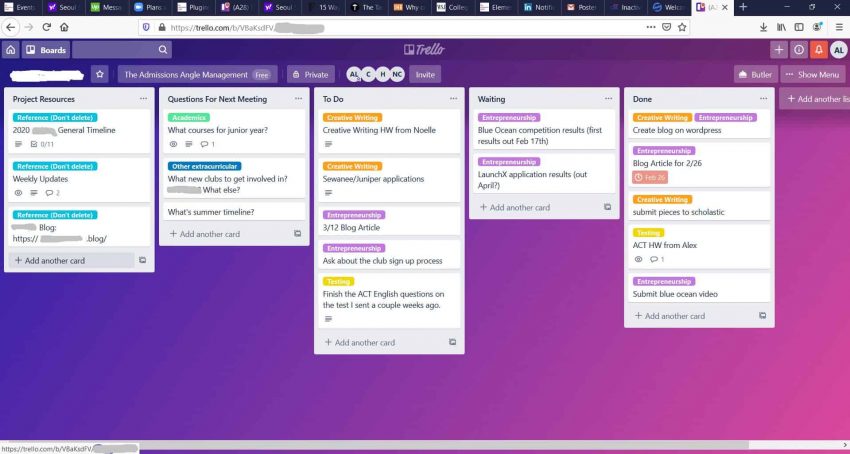Advising Services
According to the ASCA, the national ratio of guidance counselors to students is currently 408 : 1
It’s no secret that high school students get little guidance in the college admissions process. Estimates suggest that public school students receive an average of just 38 minutes of guidance in their four years of attendance. Most students don’t even know who their guidance counselor is until the end of their junior year.
The Admissions Angle is proud to work with students 1 : 1 to make sure they get the best guidance possible when making important academic, career, and personal choices.
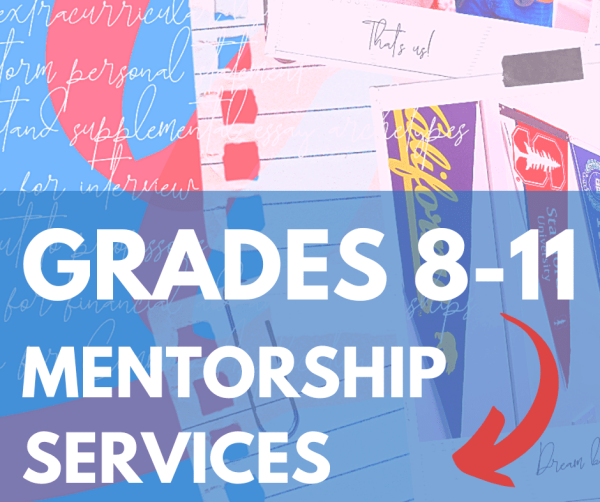
- Consistent 1-on-1 meetings with students
- Admissions Angle Discovery
- Angle development through clubs or projects
- Extracurricular and time management coaching
- Guidance on summer program applications
- Organized goals/to-do lists through project management software to keep parents up to date with progress
- Course selection consulting
- Roadmap for standardized tests
- Teacher recommendation consulting
- Guidance counselor relationship consulting
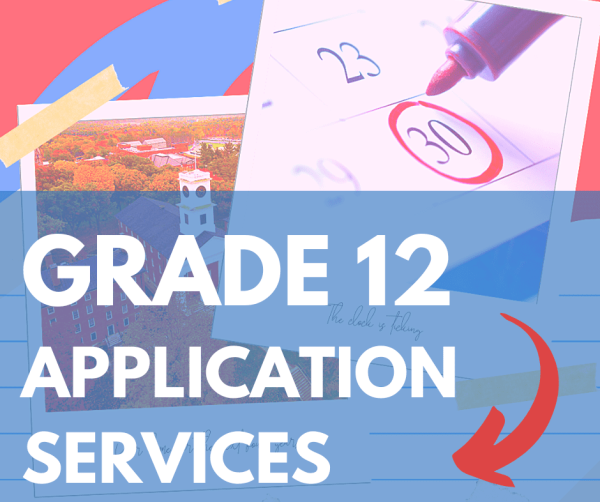
- Crafting an Admissions Angle
- Building a college list and early strategy
- Personal statement and resume
- Social media check
- College Essay Workshop
- Supplemental essay brainstorming and editing
- Application checks
- Timeline of deadlines and to-do lists
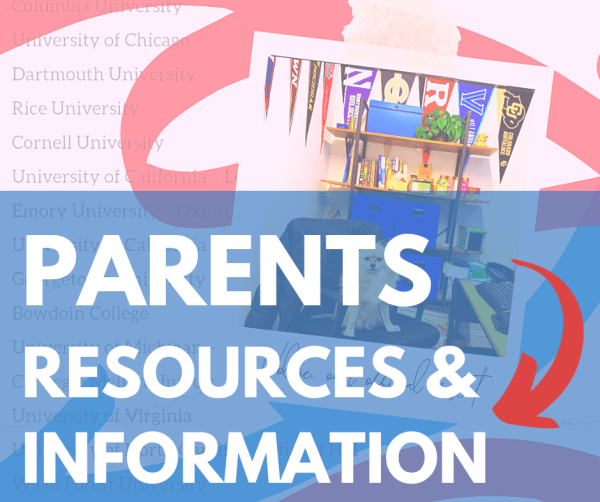
Register for a free subscription to The Admissions Angle on Substack to receive tips, articles, invitations, recordings, and insider info, straight to your inbox.
Register for a premium subscription to The Admissions Angle on Substack to receive all of the above items plus access to The College Application Lab, a 12-hour self-paced online course covering everything from strategy to essays to filling out applications, to applying for financial aid, and more.
Premium subscribers also receive access to the “chat” function, which allows you access to chat directly with Noelle or Alex via the Substack App.
Whether we like it or not, a student’s college admissions results and matriculation comprise one of the biggest decisions of their lives, determining the trajectory of their careers, their experiences with diverse people and ideas, the social circles they’ll run in, and where they decide to live after graduation. It’s an event as impactful as the birth of a child or a wedding. As many married couples meet at university, you could even say that admission to college can be even more significant than a wedding. Can you imagine working with a wedding planner who cuts you off after 38 minutes?
The average student receives just 38 minutes of 1:1 time with their counselor throughout four years of high school

Even beyond the admissions decision itself, high school is a rapid developmental period in a student’s life. During this time, students develop habits that will stick with them for years to come. More important than the college admissions decision are the skills of setting goals, planning the steps to reach them, and efficiently putting in the work to succeed. At its core, the college admissions process should be about developing the confidence to lead others and communicate effectively. To become aware of their privilege or their disadvantage and to leverage it for the betterment of their communities. These skills for long term success should be the purpose of any mentor.
How We Help

The Admissions Angle is at the core of our college admissions philosophy and its primary purpose is to help a student to stand out from the rest of the applicant pool. Essentially, it advocates for depth of expertise and interest in a few areas rather than a shallow understanding of many areas. Depth over breadth.
At the Admissions Angle, we provide our students with the time and attention they need to craft a compelling college admissions narrative. What does that look like you ask? Well, we use something called an Admissions Angle.
We know that the best way to be forgotten by an admissions officer is to come off as “well-balanced”, which is just a nicer way of saying unfocused. Well-balanced students have a number of problems in their academic profile:
- Lack of cohesion in their courses/extracurricular choices.
- Lack of time spent in a single activity/project to make a meaningful impact/achievement.
- Lack of self-awareness of who they are or what mark they want to leave on the world.
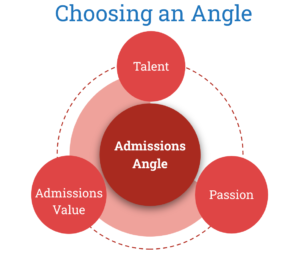
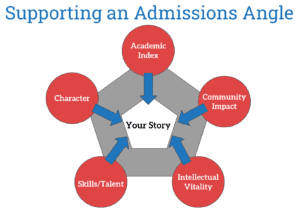
The best way to avoid this “well-balanced” trap is to create an Admissions Angle, and any effective Angle meets three criteria:
- Something with admissions value
- Something the student is good at
- Something the student loves
Without all three criteria, Admissions Angles can be unappealing (love + good at), unsupported (love + admissions value), or uninspired (good at + admissions value).
The best way to choose an appropriate Angle is for a mentor to personally get to know the student. This is where The Admissions Angle stands out.
Most competitors try to squeeze as much $/hour out of their clients so that they can take on as many students as possible. At The Admissions Angle, every student package comes with consistent scheduled meetings. This is the baseline for a successful and authentic college admissions outcome.
In addition, your son or daughter won’t be working with a college student or anyone else who couldn’t possibly have enough experience to effectively navigate the college admissions process. Every student that currently signs up with us will work directly with Alex in a meaningful way.
We find the most success with students that we’re able to mentor from 9th grade or even middle school, but it’s never too late to start. Each year of high school is faced with different goals and challenges, so it’s important to prioritize and reach each of these goals to ensure that senior year and the application process will not be more stressful than it needs to be.
9th Grade

Freshman year is the best time for students to freely explore their interests and figure out their academic path. It’s also the best time to preliminarily start thinking about the student’s admission angle. At the very least, the student should try to narrow down whether they are most interested in STEM, the humanities, or business/entrepreneurship.
Primary Goals for 9th grade:
- Adjust to a new environment and get off to a good start with grades
- Build consistent study/time management skills
- Learn how to set manageable goals and achieve them
- Explore various fields of interest and narrow down potential Angles
- Plan out a standardized test/course schedule
- Start to get more involved within the high school community
Sophomore year is the perfect time to identify a specific Admissions Angle. The Discovery process becomes more focused and the suggested activities and involvement start to involve more responsibility and specificity. It’s also when students should start taking standardized tests and thinking about summer programs.
Primary Goals for 10th grade:
- Maintain academic achievement
- Really narrow down the student’s Admissions Angle
- Start projects or clubs related to the student’s Angle
- Start taking standardized tests like Math IIC or SAT/ACT
- If student has test scores, can start applying to summer programs
10th Grade

Beginning of 11th Grade

Junior year is when stakes really start to get serious and when most students start to feel the pressure of college admissions. Students should try to finish all exams and go for leadership positions within their school clubs/communities. This year should also be used to plan the student’s schedule for the summer before senior, which is a critical time for all students.
Primary Goals for 11th grade
- Take as many AP or other advanced courses as possible without sacrificing GPA
- Cement student’s role in the high school community through involvement
- Abandon time sink activities
- Finish all standardized tests
- Apply to competitive summer programs
- Cultivate relationships with one STEM teacher, one humanities teacher, and the assigned school counselor
- Plan for Senior Community Project
College Application Services
Just like our Mentorship Services, we believe that consistent contact and a personal relationship with our students lead to the best outcomes. During senior year, we oftentimes call or chat with our students multiple times a week to guide them in setting short-term goals and brainstorming ideas for their essays. Our Application Services focus on providing the following:
- Crafting an Admissions Angle
- College list and deciding on Earlies
- Personal statement and resume
- Social Media Check
- College Essay Workshop
- Essay Brainstorming and Editing
- Application checks
- Timeline of deadlines and To-do lists
Transparency and Accountability
All students that we work with get their very own Trello project management board. We use Trello as a basecamp for mentors, students, and parents to keep track of what we’re working on. Parents stay in the loop as to what we talked about in meetings and deadlines coming up. Students can keep track of assigned worked and milestones to work towards. All work that we do is transparent and organized so that all parties involved are in the loop.

